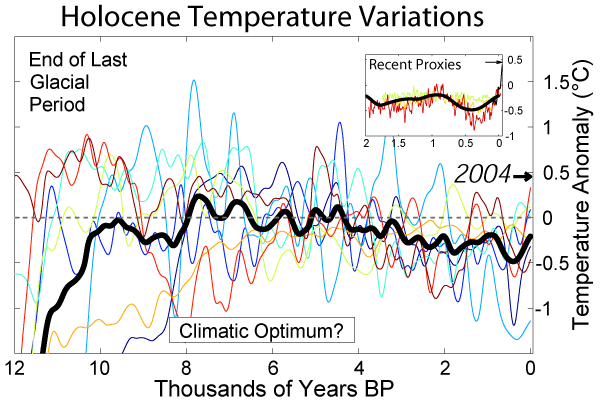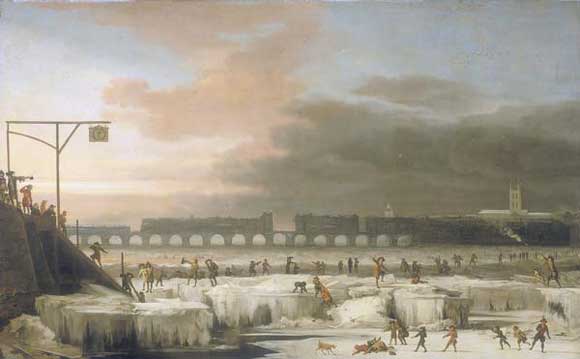With concerns over global warming, historical climatology has emerged as one of the more important cousins of environmental history. Understanding past climates is important because by understanding the nature of long-term trends and climate fluctuations we can place our present experience in an appropriate historical perspective. In addition, by learning how people in the past responded to extreme weather conditions it may be possible to design strategies to cope with climate change. Here is a brief guide exploring the methods and problems of historical climatology and the opportunities that this provides for historical researchers.
Climate: the long-term
It is often said that the climate during the Holocene was stable. The question is: stable compared to what? Generally this is taken to mean favourable for human civilisations to flourish. But this statement is problematic since climate is in a state of constant flux.
Changes in the the worlds’s temperatures over the past 12,000 years are shown below (Graph). After the last Ice Age (glaciations) ended, global temperatures appear to peak around 6000 years ago, in a period called the Holocene Climatic Optimum. Warmer temperatures were largely localised however, and concentrated in the northern hemisphere during summers; average global temperatures did not exceed those of the 20th century by much, if at all.

Source: Wikimedia Commons/Robert A. Rohde
Two features in the graph are important to note:
- over the entire 12000 year period, fluctuations were relatively small and
- during the past 6,000 yeas there has been a gradual decline in temperatures.
Why then the concern over the Little Ice Age and Medieval Warm Period?
Wine in England
In recent years wine making in England has experienced a revival encouraged by a series of warm summers. The website of the English wine producers suggests that at present extent of vineyards in Britain probably surpasses that of the Medieval Warm Period between circa 900 AD to 1300 AD. Based on this you might think vineyards are a reasonable indicator of temperature levels, and if so, that they suggests it is warmer now than between 900-1300. But is wine making really a good indicator of climate changes?
The earliest reliable record of vineyards in England is the Domesday Book, an early census commissioned by William the Conqueror to assess his new English possessions. The Domesday Book records 46 vineyards in England, all of which lie below a line from Ely in Cambridgeshire to Gloucestershire in the west. In the intermediate period it seems that the number of vineyards declined to an all time low in the 19th century when only 8 vineyards have been recorded. The problem is that this information of the early modern period is not entirely reliable because it has not been properly recorded like in the Domesday survey. A second problem is that the decline could have been related to other factors such fashions. For example it seems that the English during the 18th and 19th century preferred to drink beer and cider instead of wine. Since the second half of the 20th century there is a renewed interest in producing wine in Britain and the question is if this is climate driven or a fashion. Climate and social factors are hard to separate without a thorough historical investigation into the causes of the decline of wine production in England and English attitudes to wine drinking. Comparing this to climate the climate record of the past 400 years will possibly show a correlation, or not. What is almost certainly a climate myth are reports of vineyards in Scotland during the warm medieval period.1
Another such myth is the claim that Greenland used to be green. The accuracy of this historical claim is questionable, firstly, because much of the rhetoric in the Nordic sagas about a Greenland appears to be propaganda in order to lure colonists to settle in the newly discovered lands. Secondly, scientific research has shown that Greenland’s ice cap is hundreds of thousands of years old and has covered over 80 percent of the island since that period of time. The overwhelming majority of land not covered by the ice sheet is rock and permafrost and unsuitable for forest vegetation or large scale agriculture. It is unlikely that this was very different during the Middle Ages and that Greenland looked then much greener than today.2
Even when historical sources are reliable, their interpretation is often not as straightforward as one might assume. Take for example the so-called ‘Frost Fairs’ held in London when the River Thames froze over during the 17th, 18th and 19th centuries. This is sometimes seen as proof of how cold it was during the so-called Little Ice Age. But as with vineyards, freezing rivers are a poor indicator of climate change. It is almost certain that ice floes could get jammed under the 25 narrow arches of old London Bridge and a severe frost then locked the ice firmly together creating and ice dam. Such ice dams trapped any ice behind it, which froze then together forming an ice floor. In 1831 Old London Bridge was demolished and as a result no frost fair has occurred ever since. For example, in 1963, the third-coldest winter in England since 1659, the lower reaches of the river did not freeze, although parts of the river upstream of London did, clearly showing that something other than climate is responsible for the lack of winter mid-river freezing. Overall, the River Thames froze over only 22 times between 1408 and 1814, and that is why ‘Frost Fairs’ were held: because it was so rare. We must keep in mind that the absence of river freezing can be caused by a lack of winter cold as well as human interference in river systems such as bridge building, narrowing the riverbed for navigation increasing flow speeds, or a combination of the two.3

Frozen River Thames, December 1676. Painting by Abraham Hondius.
Note Old London Bridge in the background (Source: Wikipedia)
These examples of events in climate history are each recorded in written documents or in paintings produced during the past 500 years. But how do we get a more convincing assessment of the occurrence of Frost Fairs on the River Thames or other historical climatic events? Let’s examine this in part two in more detail.
Notes
1 Michael Le Page ,”Climate myths: It was warmer during the Medieval period, with vineyards in England”,New Scientist, 16 May 2007, http://www.newscientist.com/article/dn11644, accessed 7 April 2009.
2 “Greenland used to be green”, Grist, http://www.grist.org/article/greenland-used-to-be-green, accessed 7 April 2009
3 “Art and climate”, RealClimate, http://www.realclimate.org/index.php/archives/2006/03/art-and-climate/, accessed 7 April 2009.
George Drower, “When the Thames Froze”, Times of London, Saturday December 30, 1989,http://www.dialogselect.com/samples/NewsUK.html, accessed 7 April 2009.
Recent Comments